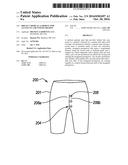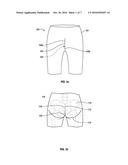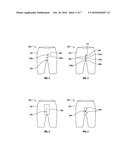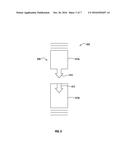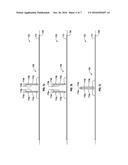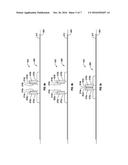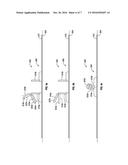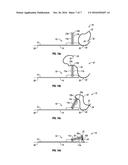Patent application title: PRIVACY MEDICAL GARMENT FOR ACCESS TO A BUTTOCKS REGION
Inventors:
IPC8 Class: AA41D1312FI
USPC Class:
1 1
Class name:
Publication date: 2016-10-20
Patent application number: 20160302497
Abstract:
A medical garment pant that provides limited but easy access to a
patient's buttocks in a manner that offers both coverage and protection
includes a garment pant having a crotch seam or backside panel; at least
one selectively closable, elongated passageway that spans a longitudinal
distance along the crotch seam or backside panel and is adapted for
central alignment with a gluteal cleft and anal orifice; and a closure
mechanism for selectively closing and opening the elongated passageway.
The closure mechanism may include a first joinder and a second joinder
that removably join sides of the elongated passageway by coming together
at a central location between ends of the elongated passageway.Claims:
1. A medical garment pant that provides limited but easy access to a
patient's buttocks in a manner that provides coverage and protection, the
medical garment pant comprising: a garment pant having a crotch seam or
backside panel; at least one selectively closable, elongated passageway
that spans a longitudinal distance along the crotch seam or backside
panel and is adapted for central alignment with an anal orifice; and a
closure mechanism that removably joins sides of the elongated passageway
to provide selective opening and closing of the elongated passageway.
2. The medical garment pant in claim 1, wherein the elongated passageway is a slit formed in a material of the garment pant, the slit having two sides that are removably joined by the closure mechanism in a location that is between ends of the slit.
3. The medical garment pant in claim 1, wherein the longitudinal distance of the elongated passageway is configured so as not to extend beyond iliac crests of a hip region on either a front side or a back side of the garment pant.
4. The medical garment pant in claim 1, wherein the longitudinal distance of the elongate passageway does not extend to a perimeter top of the garment pant.
5. The medical garment pant in claim 1, wherein the closure mechanism is a two-way zipper including first and second joinders that run along a length of the elongated passageway to form an opening that is both operator-variable in length and position such that the opening may allow minimal amount of body exposure, while providing access to the desired location.
6. The medical garment pant in claim 5, wherein the two-way zipper includes chain or teeth elements engaged by two joinder tabs such that at least a portion of the two sides are joined together when first and second joinder tabs move in closing directions along the elongated passageway and at least a portion of the two sides are unjoined from one another when the first and second tabs move in opening directions that are opposite the closing directions.
7. The medical garment pant in claim 6, wherein each tab includes either a male or female component, the male component having a protruding element that is positioned over a receiving receptacle on the female component, so that an external, downwardly directed force mechanically joins the male and female components such that the tabs are locked together.
8. The medical garment pant in claim 6, wherein the tabs include adhesive on tab sides facing each other such the tab sides may be pressed together to secure the tabs to one another.
9. The medical garment pant in claim 8, wherein each tab includes an inert padding material between an underside of the tab and the adhesive.
10. The medical garment pant in claim 6, wherein at least one tab includes a dog ear including an adhesive, which dog ear extends laterally from an upper portion of the tab, wherein the two tabs may be brought together with vertical surfaces of the two tabs in contact such that the adhesive dog ears may wrap around the two tabs to secure the two tabs together.
11. The medical garment pant in claim 6, further comprising: a zip tie having a length of a flexible plastic strand; a plurality of periodic cone-shaped bumps located along a strand length of the flexible plastic strand; a restrictive aperture at an end of the flexible plastic strand, wherein the aperture has an internal diameter so as to allow the cone-shaped bumps to pass through in one direction, but to not permit passage of the cone-shaped bumps in an opposing direction; and a hole located in each of the two tabs, wherein when the two tabs are brought together, an end of the zip tie may pass through the holes, be looped around the two tabs, passed through the restrictive aperture, and pulled until the two tabs are tightly bound.
12. The medical garment pant in claim 1, wherein the closure mechanism includes one or more clip buttons that removably join the two sides of the elongate passageway.
13. The medical garment pant in claim 1, further comprising a drape that is attached to at least one side of the elongate passageway, so as to be drapable over the elongate passageway.
14. The medical garment pant in claim 13, wherein the drape is removably attached by an adhesive, clips, buttons, Velcro, or zippers.
15. The medical garment pant in claim 1, further comprising one or more adhesive seals that may be placed over the elongate passageway to prevent further access to the elongate passageway.
16. The medical garment pant in claim 1, wherein the garment pant is made of one or more of plastic or fabric.
17. A method for performing a rectal procedure on a patient while preserving patient privacy and protection, the method comprising the steps of: providing a medical garment pant with a selectively closable, elongated passageway that spans a longitudinal distance along a crotch seam or back panel and that is in central alignment with an anal orifice; putting the medical garment pant on the patient with the elongated passageway aligned over the anal orifice of the patient's lower body; moving a closure mechanism of the medical garment pant in a first direction along the elongated passageway such that sides of the elongated passageway are separated to expose the anal orifice of the patient's lower body; performing a rectal procedure on the patient; and closing the elongated passageway such that the sides of the elongated passageway are joined together and a gluteal cleft and the anal orifice are concealed.
18. The method in claim 17, wherein the closure mechanism comprises a two-way zipper including first and second zipper joinder tabs that run along a length of the elongated passageway.
19. The method in claim 17, further comprising sealing the elongated passageway with sealing means of the medical garment pant following the rectal procedure to prevent further access to the anal orifice.
20. The method in claim 19, wherein the sealing means comprises: placing adhesive seals over the elongated passageway following the rectal procedure; locking a male component of one zipper joinder tab into a female component of another zipper joinder tab; securing two zipper joinder tabs of the closure mechanism together with adhesive; or securing two zipper joinder tabs of the closure mechanism together with a zip tie.
Description:
CROSS-REFERENCE TO RELATED APPLICATIONS
[0001] This application claims priority to and the benefit of U.S. Provisional Patent Application Ser. No. 62/178,713 filed Apr. 13, 2015, which is incorporated herein by reference in its entirety.
BACKGROUND
[0002] Coverage and protection of the patient are not always key aspects of clinical procedures and this often causes concern for both the patient and the medical community. Patients often feel significant embarrassment and a personal loss of dignity, especially female patients, as private areas are exposed to allow for a medical procedure. For example, during medical and endoscopic examination of the lower gastrointestinal tract and anorectal area, the patient's buttocks and genitalia are often exposed. Amongst personnel of the medical community, a concern also arises as to how to provide assurances to the patient that the private area has been covered after a medical procedure has been performed.
[0003] Although disposable and/or absorbent underwear or pant-like garments are available for fecal and urinary incontinence, they are not designed or intended for providing limited access to the buttock region for procedures such as colonoscopy and anoscopy. It can be an awkward, time-consuming process to put on and remove regular pants with zippers. Medical examination pants and briefs have been created with a large central hole or opening over the buttocks, but they do not provide desired coverage of the genital region and surrounding buttocks, where no access is required.
BRIEF SUMMARY
[0004] To address privacy concerns over patients' private areas, a medical garment pant as described herein may be used. A medical garment pant that provides limited but easy access to a patient's buttocks in a manner that offers both coverage and protection includes a garment pant having a crotch seam or backside panel; at least one selectively closable, elongated passageway that spans a longitudinal (e.g., generally vertical) distance along the crotch seam or backside panel and is adapted for central alignment with a gluteal cleft and anal orifice; and a closure mechanism (e.g., one or more zippers, or Velcro (hook and loop)) for closing the elongated passageway. In an embodiment, the closure mechanism may include two joinders (e.g., a two-way zipper, including two zipper tabs that zip towards one another) that removably join sides of the elongated passageway by coming together at a location between ends of the elongated passageway.
[0005] As the passageway is typically aligned to provide access to the anal orifice, which may be at or near a bottom of the generally U-shaped lower torso, between the legs, the term "longitudinal" in such context may include the under-curvature at the very bottom of the lower torso, as one traverses from the posterior side to the anterior side.
[0006] A method for performing a rectal procedure on a patient while preserving patient privacy and protection may comprise the steps of providing a medical garment pant with a selectively closable, elongated passageway that spans a longitudinal distance along a crotch seam or back panel and that is in central alignment with a gluteal cleft and anal orifice; putting the medical garment pant on the patient with the elongated passageway aligned to the gluteal cleft and anal orifice of the patient's lower body; moving a closure mechanism (e.g., a zipper tab) in a first direction along the elongated passageway such that sides of the elongated passageway are separated to expose the gluteal cleft and anal orifice of the patient's lower body; performing a rectal procedure on the patient; and closing the elongated passageway such that the sides of the elongated passageway are joined together and the gluteal cleft and anal orifice are concealed.
BRIEF DESCRIPTION OF THE DRAWINGS
[0007] FIG. 1a depicts a front view of a medical garment pant with an elongated passageway.
[0008] FIG. 1b depicts surface features and skeletal structure of a buttocks.
[0009] FIG. 2 depicts a medical garment pant having a closure mechanism comprising clip buttons.
[0010] FIG. 3 depicts a medical garment pant having a closure mechanism comprising a two-way zipper.
[0011] FIG. 4 depicts a medical garment pant having a left-sided drape for draping over the elongated passageway.
[0012] FIG. 5 depicts a medical garment pant having adhesive seals positioned over the elongated passageway, e.g., after the medical procedure.
[0013] FIG. 6 depicts a two-way zipper with a female and male locking mechanism.
[0014] FIG. 7a depicts a two-way zipper with zipper sealing means.
[0015] FIG. 7b depicts a two-way zipper with zipper sealing means as in FIG. 7a, where a non-adhesive covering has been removed, exposing the adhesive of the sealing means.
[0016] FIG. 7c depicts a two-way zipper with zipper sealing means as in FIG. 7b, where the two zipper tabs have been sealed together.
[0017] FIG. 8a depicts a two-way zipper with zipper sealing means and an inert padding material disposed between an adhesive of the sealing means and the zipper tab.
[0018] FIG. 8b depicts a two-way zipper with zipper sealing means as in FIG. 8a, where a non-adhesive covering has been removed, exposing the adhesive of the sealing means.
[0019] FIG. 8c depicts a two-way zipper with zipper sealing means as in FIG. 8b, where the two zipper tabs have been sealed together.
[0020] FIG. 9a depicts a two-way zipper with zipper sealing means, further comprising adhesive dog ears for sealing the two zipper tabs together.
[0021] FIG. 9b depicts a two-way zipper with zipper sealing means as in FIG. 9a, where a non-adhesive covering has been removed from the dog ears, exposing adhesive thereon.
[0022] FIG. 9c depicts a two-way zipper with zipper sealing means as in FIG. 9b, where the adhesive dog ears have been wrapped around the two zipper tabs, sealing the two zipper tabs together.
[0023] FIG. 10a depicts a two-way zipper with zipper sealing comprising a zip tie.
[0024] FIG. 10b depicts a two-way zipper with zipper sealing means as in FIG. 10a, where the zip tie has been threaded through both zipper tabs.
[0025] FIG. 10c depicts a two-way zipper with zipper sealing means as in FIG. 10b, where the zip tie is beginning to be tightened.
[0026] FIG. 10d depicts a two-way zipper with zipper sealing means as in FIG. 10c, where the zip tie has been fully tightened, sealing the two zipper tabs together.
DETAILED DESCRIPTION
[0027] To address privacy concerns over coverage of private areas in a buttocks region during medical procedures, an embodiment for a medical garment pant is presented. A medical garment pant that provides limited but easy access to a patient's buttocks in a manner that offers both coverage and protection includes a garment pant having a crotch seam or backside panel; at least one selectively closable, elongated passageway that spans a longitudinal distance along the crotch seam or backside panel and is adapted for central alignment with a gluteal cleft and anal orifice; and a closure mechanism that removably joins sides of the elongated passageway so as to selectively open and close the elongated passageway. In an embodiment, the closure mechanism may include first and second joinders (e.g., zipper tabs, etc.) that are movably disposed along the passageway, so as to come together and define an opening in the elongated passageway therebetween. Such a configuration allows the medical practitioner to zip or otherwise move the joinders (e.g., zipper tabs) to the desired locations, defining the access opening (e.g., for performing a colonoscopy or other procedure) therebetween.
[0028] According to another aspect, a method for performing a rectal procedure on a patient while preserving patient privacy and protection is provided. Such a method may comprise the steps of: providing a medical garment pant with a selectively closable, elongated passageway that spans a longitudinal distance along a crotch seam or back panel and that is in central alignment with a gluteal cleft and anal orifice when worn; putting the medical garment pant on the patient with the elongated passageway aligned with the gluteal cleft and anal orifice of the patient's lower body; moving a closure mechanism (e.g., a zipper tab) in a first direction along the elongated passageway such that sides of the elongated passageway are separated to expose the gluteal cleft and anal orifice of the patient's lower body; performing a rectal procedure on the patient; and closing the elongated passageway such that the sides of the elongated passageway are joined together and the gluteal cleft and anal orifice are concealed.
[0029] A medical garment pant 100 is shown in FIG. 1a includes a garment pant 101 with a selectively closeable, elongated passageway 104. The garment pant 101 may include a crotch seam 102 or a back panel (e.g., with seams on either side). The crotch seam 102 is understood to be directed downward along a natal cleft of a buttock region such that it is centrally aligned with the natal cleft. Where a crotch seam 102 is provided along the natal cleft, the elongated passageway may be aligned with the seam (i.e., the passageway may be positioned in the seam). If a back panel is provided instead of a crotch seam, the elongated passageway 104 may be positioned in the back panel, centrally aligned with the natal cleft and follow at least a portion of a similar path (i.e., aligned with the natal cleft).
[0030] The crotch seam 102 may curve underneath the buttocks region and around to a crotch region and upwards along an anterior pelvic region. The elongated passageway 104 follows at least a portion of the path of such a crotch seam 102, and at least spans a longitudinal distance along the crotch seam 102 such that it provides limited but easy access to an anal orifice of the buttocks. Access may further extend to genitalia and/or the anterior pelvic region. In another embodiment, the elongated passageway 104 does not extend to genitalia or the anterior pelvic region, but extends only along the rear portion of the garment pant. In an embodiment, the elongated passageway extends longitudinally (e.g., generally vertically), but stops short of the top of the garment pant. In other words, the passageway may not touch the top perimeter edge of the garment top, but is wholly disposed within the central portion of the garment pant. The center point between endpoints of the elongated passageway 104 may correspond with a location directly over the anal orifice, or other location to be accessed.
[0031] Turning to FIG. 1b, a buttocks 110 is shown, including both exterior surface landmarks and internal bony structures, reference to which can be used to define the elongated passageway 104, any closure mechanisms used to join sides of the elongated passageway, or any sealing mechanisms used to lock access to the elongated passageway. Outer surfaces referenced may include, for example, a natal cleft 112 or gluteal fold 114. Other outer surfaces which may serve as references, which are not shown, but which will be familiar to those of skill in the art may include a most superior point of the iliac crest, dimple for posterior superior iliac spine, hollow posterior to the greater trochanter, greater trochanter, ischial tuberosity, gluteus medius, and gluteus maximus.
[0032] Internal bony structures referenced may include, for example, an iliac crest 116, sacrum 118, or coccyx 120. Other internal bony structures, not shown, but which will be familiar to those of skill in the art may include iliac crest, posterior superior iliac spine, ischial tuberosity, greater sciatic notch, ischial spine, and lesser sciatic notch.
[0033] Various internal bony structures and exterior surface landmarks may be used for reference (e.g., for location of the passageway 104), including those that extend downward from the buttocks and around to a frontal region. They include, for example, inguinal ligament, pubic crest, pubic tubercle, anal triangle, clitoris, urethral opening, labia, vaginal opening, penis, and testicles. The urogenital triangle may be used as well, including bony landmarks of pubic symphosis, lateral border of ischiopubic rami and sacrotuberous ligament, and inferior border tip of the coccyx. Exterior surface borders of the urogenital triangle include an anterior border being a mons pubis, lateral border being a medial surface of a thigh, and inferior border being an intergluteal cleft. Those of skill in the art will appreciated that while described principally in the context of an elongated passageway aligned so as to provide medical practitioner access to the anus for a colonoscopy, various other configurations may be provided for other procedures, so as to provide needed limited access to the practitioner, while providing clothing coverage to other locations to which access is not needed for a given procedure.
[0034] Referring back to FIG. 1a, the elongated passageway 104 may be in the form of a slit or cut formed in a material of the garment such that two sides 106a and 106b are cut or otherwise separated into two portions. The two portions may be left and right halves, as the passageway runs down the center axis of the garment pant. Other portions of the left and right portions on either side of the endpoints of the passageway may be joined to one another (e.g., by seam 102). In this manner, the elongated passageway 104 may be at least partially opened by a medical practitioner during a procedure to allow access to the desired location (e.g., the anus), while at the same time maximizing coverage of a patient's private area, also referred to as private parts.
[0035] Instead of a slit whereby the two sides 106a and 106b meet and form a line at seam 102, the two sides may slightly extend over each other, such that an overlapping configuration is assumed, with one half side at least partially on top of the other half side. Alternatively, a first side may remain with the same dimensions as for the slit configuration, and a second side may be widened such that it reaches or extends over the first side. Various other configurations as employed in garment manufacture, providing a seam and/or back panel are possible, and will be appreciated by those of skill in the art.
[0036] Different mechanisms may be used to connect or attach the two sides of the elongated passageway 104, allowing selective closing and opening of passageway 104. FIG. 2 illustrates a medical garment pant 200 that includes a garment pant 201 having an elongated passageway 204 with sides 206a and 206b that are removably joined by clip buttons 208, also referred to as snap buttons. One or more of the clip buttons 208 may be opened for a medical procedure and then closed upon completion of the medical procedure. As an alternative, regular buttons with buttonholes may be used. While clip buttons 208 are shown to one side of passageway 204 for purposes of clarity in showing the passageway 204, it will be appreciated that the buttons 208 may be aligned directly over passageway 204, or to either side thereof. For example, a flap of material from the opposite side of passageway 204 may include a portion of the clip button 208 attached thereto, to snap closed over passageway 204.
[0037] The clip buttons 208 may be evenly spaced apart, longitudinally, along the full length of elongated passageway 204. In another embodiment, clip buttons 208 may be centrally located over the location to be accessed, such as the anal orifice. There may be as few as one clip button, or a plurality of such buttons. For example, one clip button may be centered between endpoints of the elongated passageway 204 and may or may not be located over the location to be accessed. Also, there may be more than one clip button, e.g., equally or unequally spaced apart along a length of the passageway 204.
[0038] Instead of clip buttons, removable clips may be used such that when not being used to join the two sides in a joined or closed position, the removable clips may be used to hold passageway 204 open. For example, such removable clips may attach the two sides 206a and 206b adjacent passageway 204 to outer sides of the garment pant 201, away from passageway 204. In this manner, the removable clips may serve a dual purpose, both to close, or join, the two sides of the elongated passageway and to hold open, or hold separate the two sides 206a and 206b while a medical procedure is performed. After the medical procedure is completed, the removable clips may then be used to reattach the two sides together and at least partially close the elongated passageway 204.
[0039] Turning to FIG. 3, a medical garment pant 300 includes garment pant 301 having an elongated passageway 304 with sides 306a and 306b joined by a two-way zipper 308. The two-way zipper 308 runs along a length, e.g., up to the entire length of the elongated passageway 304 to selectively open and close passageway 304. The opening may be both operator-variable in size and position such that the opening may allow minimal amount of body exposure. In other words, the operator may select the size (i.e., length) and position of the opening, to provide minimal exposure, while at the same time provided the needed access. The two-way zipper 308 may include chain (also referred to as teeth) elements 312 on sides 306a and 306b, the chain elements 312 removably engaged with one another by first and second joinders (e.g., zipper tabs) 310a and 310b of the two-way zipper 308. At least a portion of the two sides are joined when first and second joinders 310a and 310b move in first directions along the elongated passageway and the at least a portion of the two sides 306a and 306b are unjoined from the chain when the first and second joinders 310a and 310b move in second directions that are opposite the first direction. First directions (i.e., for closure) may include the first and second joinders 310a and 310b moving from endpoints of the elongated passageway 304 towards each other. Second directions (for opening) may include the first and second joinders 310a and 310b moving in an opposing direction, such that the first and second joinders 310a and 310b move away from each other. The first and second joinders 310a and 310b may be positioned to come together at or near the location to be accessed, such as edges of an anal orifice. The location to be accessed, and thus the location of the joinders 310a and 310b, may correspond to a central position between endpoints of the elongated passageway 304, endpoints of the two-way zipper 308, or both.
[0040] After a procedure, the first and second joinders 310a and 310b may be moved to together such that facing surfaces of the first and second joinders 310a and 310b are touching, or nearly touching each other. The two joinders may be locked or secured together, preventing further access. The point of location for joining together may be directly over or near the accessed location. The two-way zipper 308 allows for a minimal amount of exposure during a medical procedure, such as an examination or endoscopy insertion.
[0041] The medical garment pant does not merely include a normal pant zipper. A normal pant zipper is used to increase or decrease the circumference of the pelvic region and/or waist area of a pair of pants. Such a pant zipper extends to the perimeter edge (e.g., the top perimeter edge) of the pants, to provide for such waistline expansion. For example, when a pant zipper is pushed vertically upward on the anterior side of the pants, the waist opening is decreased. When the pant zipper is pushed vertically downward on the anterior side of the pants, the waist opening is increased. The two-way zipper 308, however, provides no such functionality. When first joinder 310a moves vertically upward relative to the pelvic and buttock region, it is not closing the elongated passageway 304, and not closing the pants, but rather, opening the elongated passageway 304. When the first joinder 310a moves generally downward, it is not opening the pants, but is rather closing the elongated pathway 304. In this manner, the first joinder 310a of two-way zipper 308 has the opposite effect as a regular pant zipper. Furthermore, operation of the zipper 308 does not serve to adjust the waistline opening of the pants, which remains constant no matter the position of zipper 308, as zipper 308 does not reach to the top perimeter of pants 301.
[0042] The two-way zipper 308 may extend to a location that is just below the waistband of the pants, typically on the posterior side of the garment pant 301, so as to provide for anal access. In some embodiments, the zipper may extend to the anterior side of the garment pant 301, depending on the location to be accessed. In any case, by way of example, the two-way zipper 308 may terminate oat a location that is 1 inch, 2 inches, 3 inches, 4 inches, 5 inches, 6 inches, 7 inches, or a range defined between any such values, below a waistband of the garment pant 301. The garment pant 301 may have an elastic waistband to aid in placement of the garment pant 301 over the patient, and in keeping the garment pant 301 in place. In another embodiment, the garment pant may include a typical pant zipper for waistline expansion, in addition to the zippered or other closured elongated passageway for medical procedure access.
[0043] Prior to a medical procedure, the elongated passageway may be closed as described herein, such as by clip buttons or two-way zippers. In addition, or alternatively, the elongated passageway may be at least partially, or completely, covered by a drape. FIG. 4 shows an embodiment of a medical garment pant 400 including a left-sided drape 408, meaning that the drape 408 is attached at a wearer's left side of the elongated passageway 404 on the garment pant 401, such that medical personnel could lift a right side of the drape 408 to access passageway 404. Unless otherwise specified, directional ques are relative to the wearer of the medical garment pant. In an embodiment, the drape 408 may be removable (e.g., Velcro). The left-sided drape 408 may be attached directly adjacent or near the left side of the elongated passageway 404. Alternatively, the drape 408 may be a right-sided drape, meaning that the drape 408 is attached at a right side of the elongated passageway 404 on the garment pant 401. A left sided drape may be particularly configured for easy right-handed operation. Moreover, the drape 408 could be attached at the top or bottom of the elongated passageway 404 and then be removed or folded over a respective end of the elongated passageway 404.
[0044] After completion of a medical procedure, an adhesive seal may be used to cover the elongated passageway, or another mechanism may be provided for preventing further access to the private parts of the patient. As shown in FIG. 5, medical garment pant 500 includes garment pant 501 with an elongated passageway 504 being covered by adhesive seal 508. The adhesive seal 508 may be used in conjunction with, or in place of, other closure means, such as clip buttons or the two-way zipper, following a medical procedure to seal the elongated passageway. After the medical procedure, a physician or other medical personnel may place one or more adhesive seals 508 over the elongated passageway 504. This can help a patient feel more comfortable, e.g., while recovering from sedation in the recovery room, knowing that his or her private parts were covered after the procedure.
[0045] Another approach for a sealing means after a medical procedure is to provide a means for mechanically securing together the zipper tabs or joinders. In FIG. 6, zipper sealing means 600 includes a two-way zipper 608 with first and second joinders 610a and 610b. First and second joinders 610a and 610b may be similar to first and second joinders previously described, and in which one joinder (e.g., second joinder 610b) includes a female component 612 and the other joinder (e.g., first joinder 610a) includes a male component 614. As such, male component 614 may be a protruding element on first joinder 610a and female component 612 is a receiving receptacle on second joinder 610b.
[0046] Male component 614 may be positioned within, directly above, or over female component 612, depending on the particular receptacle configuration. For example, the receptacle may have an internal cavity located on a side facing the first direction of movement (i.e., closure) of the second joinder 610b. The cavity or insert or other type of receptacle in one joinder may be aligned with the male component 614 of the other joinder. Other types of receptacles will be appreciated by those of skill in the art.
[0047] Male component 614 may protrude in the first direction of movement (i.e., closure), aligned with a corresponding female component 612. The male component 614 may protrude downward, be angled, or have downward curvature corresponding to the female component 612, being on top of the other joinder (e.g., second joinder 610b). The female component 612 and the male component 614 may be mechanically joined via application of an external, downwardly-directed force. For receptacles along sides of the second joinder 610b, the female component 612 and male component 614 may be joined by external forces applied on sides of the female component 612 and the male component 614.
[0048] Once the first and second joinders 610a and 610b have been snapped, or joined, together, disconnecting the pair of joinders 610a and 610b may be such that it requires a significant mechanical force, such that tools beyond average human hands would be required. For example, the illustrated configuration shows an enlarged head on male component 614 that may deform as it passes through the entry neck of receptacle 612, and then snaps back to its undeformed shape, filling the distal enlarged region at the end of receptacle 612. Such a configuration will be difficult to separate once the two joinders are locked together. Such a joinder may be used to offer the patient physical evidence that the elongated passageway has not been accessed since the conclusion of the medical procedure.
[0049] Another approach for closure that may be used to provide evidence to the patient includes joinders that include an adhesive on joinder sides facing each other such that upon removal of non-adhesive coverings on the adhesive, the joinder sides facing each other may be pressed together for securement of the joinders. As shown in FIGS. 7a-7c, a zipper sealing means 700 for a two-way zipper 708 with first and second joinders 710a and 710b, can be joined together with adhesive 714a, 714b.
[0050] As shown, first and second joinders 710a and 710b may be in the form of tabs (e.g., zipper tabs) that may be articulated to stand vertically upward relative to chain or teeth elements 712. Each tab 710a and 710b may include a respective underside 716a and 716b, meaning a side of tab 710a that faces a side of 710b when both are standing in a vertical direction. Each underside 716a and 716b may have an adhesive surface 714a and 714b, or adhesive tape, that may be initially covered with a respective non-adhesive covering 718a and 718b, such as a non-adhesive (e.g., waxy) covering paper. At the conclusion of a medical procedure, the first and second tabs, or joinders, 710a and 710b, may be brought together, thus completely closing, or nearly closing, the elongated passageway 704 used during the medical procedure. The non-adhesive coverings 718a and 718b may be peeled off of each tab's adhesive underside 716a and 716b, thus exposing the adhesive surfaces 714a and 714b. The undersides 716a and 716b are then pressed together, thus securely sealing the two zipper tabs together.
[0051] In order to ensure that the adhesive underside of the zipper tabs may contact each other completely and in a parallel manner, it may be helpful to uniformly increase the thickness of the undersides of the zipper tabs. FIGS. 8a-8c shows a zipper sealing means 800 for a two-way zipper 808 having first and second joinders 810a and 810b that join chain or teeth elements 812. Adhesive tape 814a and 814b may be attached at undersides 816a and 816b, respectively. Non-adhesive coverings 818a and 818b may be attached to outer surfaces of adhesive tape 814a and 814b. Also, inert padding 820a and 820b may be attached between the undersides 816a and 816b and corresponding adhesive 814a and 814b, lessening the gap between adhesive 814a and 814b, when the two-way zipper is already substantially closed.
[0052] The thickness of the inert padding 820a and 820b between undersides 816a and 816b and corresponding adhesive tape 814a and 814b may be a distance between any typical protruding features of the zipper tabs 810a and 810b and outer surfaces of respective undersides 816a and 816b of the zipper tabs 810a and 810b. For example, the male component 614 as described for FIG. 6 may be the most protruding feature. Alternatively, one or both zipper tabs 710a and 710b may have a curved or undulating configuration and the inert padding 820a and 820b may fill in curves and form planar surfaces upon which the adhesive tapes 714a and 714b may be attached. In this manner, the attachment can be a parallel attachment.
[0053] In another alternative configuration that provides the previously disclosed functionality of ensuring the closure of the dual zipper design, two-way zipper tabs are joined by wrapping adhesive tape around the two-way zipper tabs. This can be accomplished by two adhesive tape "dog ears." Dog ears include members that are attached to, and/or hang from, tabs like dog ears. FIGS. 9a-9c show zipper sealing means 900 that seals elongated passageway 904 using a two-way zipper 908 that joins teeth elements 912 with first and second tabs 910a and 910b. Adhesive tape dog ears 922a and 922b extend laterally away from an upper portion of tabs 910a and 910b as shown in FIG. 9a. Dog ears 922a and 922b may be covered by non-adhesive coverings 924a and 924b, which may be peeled off after the procedure is finished to expose adhesive surfaces 914a, 914b of dog ears 922a and 922b, as shown in FIG. 9b. The two tabs 910a and 910b are then brought together in a parallel manner, whether it be both standing vertical, slightly angled, angled, or relatively horizontal, and the adhesive tape dog ears 922a and 922b are wrapped around both tabs 910a and 910b, as shown in FIG. 9c. While both dog ears 922a and 922b are shown attached to one of the tabs (910a), it will be appreciated that the dog ears may be provided on the other tab, or one or more dog ears on each tab.
[0054] In another alternative configuration that provides the previously disclosed functionality of ensuring the closure of the dual zipper design, zip ties may be used. In FIGS. 10a-10d, the process of sealing elongated passageway 14 with zipper sealing means 10 is shown, and includes two-way zipper 18, teeth elements 12, and first and second tabs 11a and 11b. Also included is a zip tie 22 which may be located at or near endpoint 26 of the elongated passageway 14, with attachment to the fabric of the garment pant. Alternatively, zip tie 22 could be attached at or near an endpoint of the two-way zipper 18. The endpoints of the two-way zipper 18 and elongated passageway 14 may be the same or different. Instead of attachment at or near an endpoint 26 of the elongated passageway 14, the zip tie 22 could be attached at or near a position where both sides of the elongated passageway 14 are joined together, whether the joinders be together at an endpoint of the elongated passageway 14, together over the accessed location, and/or centered between endpoints of the elongated passageway 14. In another embodiment, the zip tie 22 may be provided separate from the garment pant, and similarly used to secure one tab 11a to the other tab 11b.
[0055] The zip tie 22 may be of a common configuration, having a single strand length of flexible plastic and periodic cone-shaped or other shaped protruding bumps along the strand length. Other types of zip ties may be used. Additionally, at or near the end of the strand, a restrictive aperture 24 may be located, the restrictive aperture 24 being large enough so as to allow the cone-shaped bumps of the strand to pass through the restrictive aperture with minimal elastic deformation of both entities (e.g., in an orientation where the pointed end of the cones leads), but to not allow for passage for the cone-shaped bumps in a reverse direction, as the base of the cones then lead, and catch on the edges of the aperture 24.
[0056] The first and second tabs 11a and 11b may each have a hole 23a and 23b, respectively, at or near free ends. After completion of a medical procedure, the first and second tabs 11a and 11b may be pulled to the same endpoint 26 or other desired location as shown in FIG. 10a. An appropriate length of zip tie 22 may be attached at or near an end 30 of the zip tie 22. The other end 32 of the zip tie 22 may be free. The free end 32 of the zip tie 22 passes through both of the holes 23a and 23b of associated zipper tabs 11a and 11b, as shown in FIG. 10b. While aperture 24 is shown at free end 32, it may alternatively be at the opposite, attached end. The free end 32 may then loop around and return to the restrictive aperture 24, as shown in FIG. 10c. A securing method is completed by passing one end of the zip tie 22 through the restrictive aperture 24 and pulling that end until both zipper tabs 11a and 11b are tightly bound, as shown in FIG. 10d. In this manner, proof of securement may be provided to the wearer.
[0057] The zipper tabs 11a and 11b may thus be secured by the zip tie 22 in a vertical, angled, horizontal, or nearly horizontal configuration. A nearly horizontal configuration is shown in FIG. 10d.
[0058] Alternatively, although the zip tie 22 may be initially attached at an end to a location along the length of the elongated passageway 14, the zip tie 22 may be removable such that it can be moved to a desired location for tying the first and second tabs.
[0059] In addition to the garment pant examples described herein, an underlying brief to be worn underneath the garment pant may also be included. The underlying brief provides an additional layer of protection underneath the garment pant. The underlying brief may include a posterior portion that provides an opening configured to be over a buttocks region, and particularly an anal orifice, while maintaining coverage of a genital region. This may be useful, for example, if the elongated passageway extends over the genital region such that the genital region could otherwise be accessed or made visible without the presence of the underlying brief.
[0060] A method for performing a rectal procedure on a patient while preserving patient privacy and protection may comprise the steps of providing a medical garment pant with a selectively closable, elongated passageway that spans a longitudinal distance along a crotch seam or back panel and that is in central alignment with a gluteal cleft and anal orifice; putting the medical garment pant on the patient with the elongated passageway aligned over the gluteal cleft and anal orifice of the patient's lower body; moving a closure mechanism in a first direction along the elongated passageway such that sides of the elongated passageway are separated to expose the anal orifice of the patient's lower body; performing a rectal procedure on the patient; and closing the elongated passageway such that the sides of the elongated passageway are joined together and the gluteal cleft and anal orifice are concealed.
[0061] The medical garment pant employed in the method may incorporate any of the features described herein. For example, the method may further comprise the step of providing an underlying brief to be worn underneath the garment pant, the underlying brief having a posterior portion that provides an opening configured at a buttock region and coverage provided over a genital region. Similarly, any of the above described methods for sealing the elongated passageway after completion of the medical procedure may be included in such overall methods.
[0062] The medical garment pant and/or brief may be made of disposable plastic, such a non-woven cellulosic material. Alternatively, the material may be washable and reusable. The medical garment pant and/or brief may come in a variety of sizes, have gender specific constructions, or be made to fit a standard person. A standard person may be a mathematical model of a person based on any suitable data that simulates a person's size, body proportions, and the like. The model can be based upon data, for example, used in the clothing industry to define sizes for apparel and the like. The standard person used and the data set used to derive the standard person may be chosen with the user of the medical Garment pant in mind and can be based upon average values of body proportions from any sample of the population from, for example, total population, gender, age, body size or weight, nationality, ethnicity, or the like. The standard person may also be based upon any particular individual, or group of individuals. Thus, the standard person for a medical garment pant may be designed for marketing to the public in general, or be customized to fit a particular group of people, or to fit an individual. The medical garment pant may be provided in various sizes (e.g., small, medium, large, x-large, etc.).
[0063] Applicant's companion application, entitled PRIVACY MEDICAL GARMENT FOR ACCESS TO PATIENT'S TORSO, filed the same day as the present application is herein incorporated by reference in its entirety. Any of the configurations disclosed therein with respect to closure mechanisms, and other features in the context of the medical garment top may be applied herein to the described medical garment pant.
[0064] The present disclosure may be embodied in other specific forms without departing from its spirit or characteristics. The described embodiments are to be considered as illustrative and not restrictive. The scope of the disclosure is, therefore, indicated by the appended claims rather than by the foregoing description. Changes that come within the meaning and range of equivalency of the claims are to be embraced within their scope.
User Contributions:
Comment about this patent or add new information about this topic:

